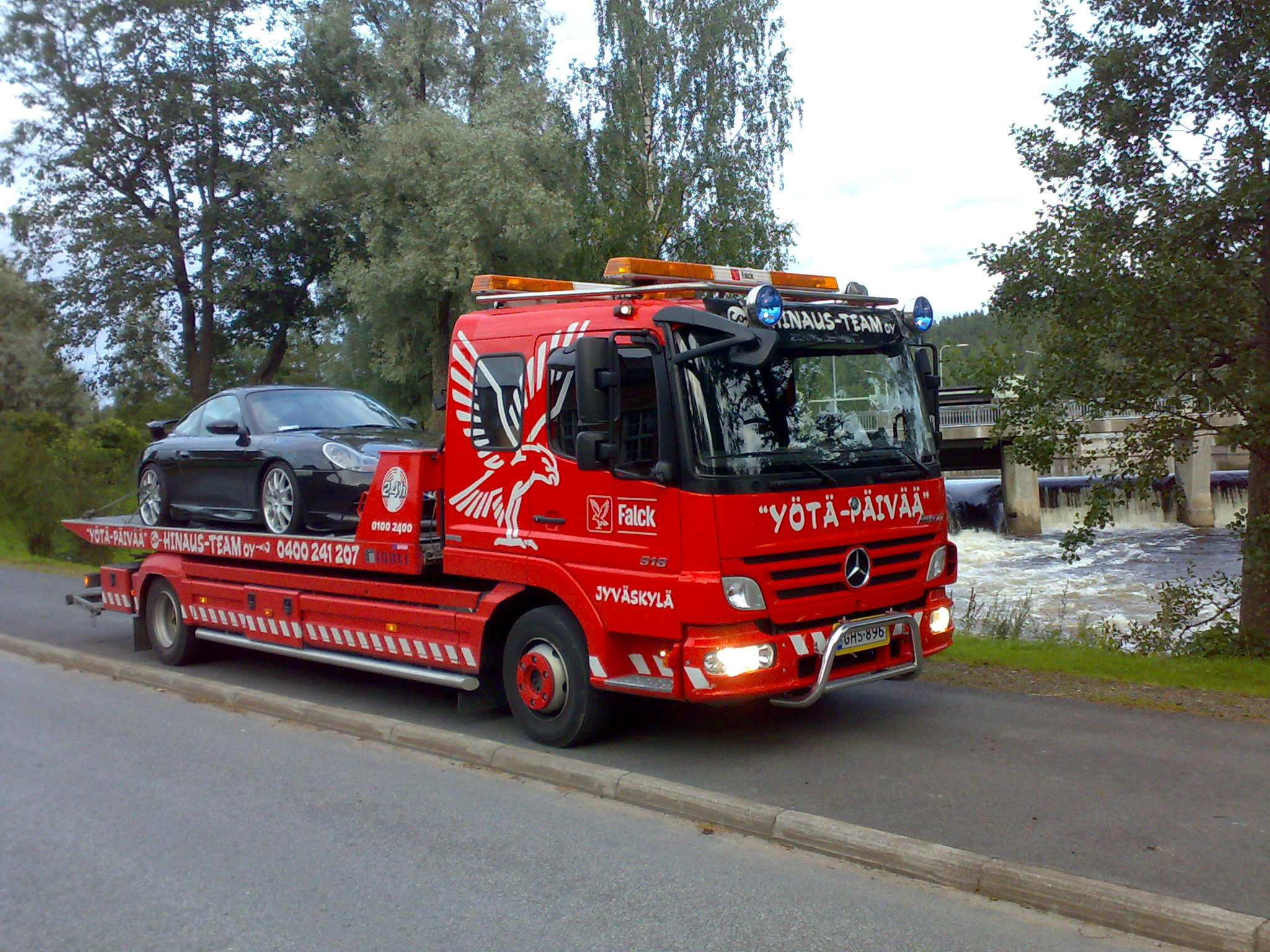|
Winch
A winch is a mechanical device that is used to pull in (wind up) or let out (wind out) or otherwise adjust the tension of a rope or wire rope (also called "cable" or "wire cable"). In its simplest form, it consists of a spool (or drum) attached to a hand crank. Traditionally, winches on ships accumulated wire or rope on the drum; those that do not accumulate, and instead pass on the wire/rope (see yacht photo above), are called capstans. Despite this, sailboat capstans are most often referred to as winches. Winches are the basis of such machines as tow trucks, steam shovels and elevators. More complex designs have gear assemblies and can be powered by electric, hydraulic, pneumatic or internal combustion drives. It might include a solenoid brake and/or a Mechanical brake stretch wrapper, mechanical brake or ratchet (device), ratchet and pawl which prevents it unwinding unless the pawl is retracted. The rope may be stored on the winch. When trimming a line on a sailboat, the ... [...More Info...] [...Related Items...] OR: [Wikipedia] [Google] [Baidu] |
Winch
A winch is a mechanical device that is used to pull in (wind up) or let out (wind out) or otherwise adjust the tension of a rope or wire rope (also called "cable" or "wire cable"). In its simplest form, it consists of a spool (or drum) attached to a hand crank. Traditionally, winches on ships accumulated wire or rope on the drum; those that do not accumulate, and instead pass on the wire/rope (see yacht photo above), are called capstans. Despite this, sailboat capstans are most often referred to as winches. Winches are the basis of such machines as tow trucks, steam shovels and elevators. More complex designs have gear assemblies and can be powered by electric, hydraulic, pneumatic or internal combustion drives. It might include a solenoid brake and/or a Mechanical brake stretch wrapper, mechanical brake or ratchet (device), ratchet and pawl which prevents it unwinding unless the pawl is retracted. The rope may be stored on the winch. When trimming a line on a sailboat, the ... [...More Info...] [...Related Items...] OR: [Wikipedia] [Google] [Baidu] |
Capstan (nautical)
A capstan is a vertical- axled rotating machine developed for use on sailing ships to multiply the pulling force of seamen when hauling ropes, cables, and hawsers. The principle is similar to that of the windlass, which has a horizontal axle. History The word, connected with the Old French ''capestan'' or ''cabestan(t)'', from Old Provençal ''cabestan'', from ''capestre'' "pulley cord," from Latin ''capistrum'', -a halter, from ''capere'', to take hold of, seems to have come into English (14th century) from Portuguese or Spanish shipmen at the time of the Crusades. Both device and word are considered Spanish inventions. Early form In its earliest form, the capstan consisted of a timber mounted vertically through a vessel's structure which was free to rotate. Levers, known as bars, were inserted through holes at the top of the timber and used to turn the capstan. A rope wrapped several turns around the drum was thus hauled upon. A rudimentary ratchet was provided to hold t ... [...More Info...] [...Related Items...] OR: [Wikipedia] [Google] [Baidu] |
Tow Truck
A tow truck (also called a wrecker, a breakdown truck, recovery vehicle or a breakdown lorry) is a truck used to move disabled, improperly parked, impounded, or otherwise indisposed motor vehicles. This may involve recovering a vehicle damaged in an accident, returning one to a drivable surface in a mishap or inclement weather, or towing or transporting one via flatbed to a repair shop or other location. A tow truck is distinct from a car carrier trailer, which is used to move multiple new or used vehicles simultaneously in routine transport operations. History Ferdinand Porsche of Austro-Daimler developed an artillery tractor for the Austro-Hungarian army in 1908, the M 08. One of the batch was constructed as a recovery vehicle for the others, with a large winch on the rear platform. The wrecker (with lifting jib) was invented in 1916 by Ernest Holmes Sr. of Chattanooga, Tennessee, a garage worker who was inspired after he needed blocks, ropes, and six men to pull a car ou ... [...More Info...] [...Related Items...] OR: [Wikipedia] [Google] [Baidu] |
Steam Shovel
A steam shovel is a large steam-powered excavating machine designed for lifting and moving material such as rock and soil. It is the earliest type of power shovel or excavator. Steam shovels played a major role in public works in the 19th and early 20th century, being key to the construction of railroads and the Panama Canal. The development of simpler, cheaper diesel-powered shovels caused steam shovels to fall out of favor in the 1930s. History Origins and development Grimshaw of Boulton & Watt devised the first steam-powered excavator in 1796. In 1833 William Brunton patented another steam-powered excavator which he provided further details on in 1836. The steam shovel was invented by William Otis, who received a patent for his design in 1839. The first machines were known as 'partial-swing', since the boom could not rotate through 360 degrees. They were built on a railway chassis, on which the boiler and movement engines were mounted. The shovel arm and driving engines ... [...More Info...] [...Related Items...] OR: [Wikipedia] [Google] [Baidu] |
Wire Rope
Steel wire rope (right hand lang lay) Wire rope is several strands of metal wire twisted into a helix forming a composite ''rope'', in a pattern known as ''laid rope''. Larger diameter wire rope consists of multiple strands of such laid rope in a pattern known as ''cable laid''. In stricter senses, the term ''wire rope'' refers to a diameter larger than , with smaller gauges designated cable or cords. Initially wrought iron wires were used, but today steel is the main material used for wire ropes. Historically, wire rope evolved from wrought iron chains, which had a record of mechanical failure. While flaws in chain links or solid steel bars can lead to catastrophic failure, flaws in the wires making up a steel cable are less critical as the other wires easily take up the load. While friction between the individual wires and strands causes wear over the life of the rope, it also helps to compensate for minor failures in the short run. Wire ropes were developed starting with min ... [...More Info...] [...Related Items...] OR: [Wikipedia] [Google] [Baidu] |
Crank (mechanism)
A crank is an arm attached at a right angle to a rotating shaft by which circular motion is imparted to or received from the shaft. When combined with a connecting rod, it can be used to convert circular motion into reciprocating motion, or vice versa. The arm may be a bent portion of the shaft, or a separate arm or disk attached to it. Attached to the end of the crank by a pivot is a rod, usually called a connecting rod (conrod). The term often refers to a human-powered crank which is used to manually turn an axle, as in a bicycle crankset or a brace and bit drill. In this case a person's arm or leg serves as the connecting rod, applying reciprocating force to the crank. There is usually a bar perpendicular to the other end of the arm, often with a freely rotatable handle or pedal attached. Examples Familiar examples include: Hand-powered cranks * Spinning Wheel * Mechanical pencil sharpener * Fishing reel and other reels for cables, wires, ropes, etc. *Starting ... [...More Info...] [...Related Items...] OR: [Wikipedia] [Google] [Baidu] |
Rope
A rope is a group of yarns, plies, fibres, or strands that are twisted or braided together into a larger and stronger form. Ropes have tensile strength and so can be used for dragging and lifting. Rope is thicker and stronger than similarly constructed cord, string, and twine. Construction Rope may be constructed of any long, stringy, fibrous material, but generally is constructed of certain natural or synthetic fibres. Synthetic fibre ropes are significantly stronger than their natural fibre counterparts, they have a higher tensile strength, they are more resistant to rotting than ropes created from natural fibres, and they can be made to float on water. But synthetic ropes also possess certain disadvantages, including slipperiness, and some can be damaged more easily by UV light. Common natural fibres for rope are Manila hemp, hemp, linen, cotton, coir, jute, straw, and sisal. Synthetic fibres in use for rope-making include polypropylene, nylon, polyesters (e.g. ... [...More Info...] [...Related Items...] OR: [Wikipedia] [Google] [Baidu] |
Pawl
A pawl is a movable lever that engages a fixed component to either prevent movement in one direction or restrain it altogether. As such, it is a type of latch and can also be considered a type of dog. It typically consists of a spring-loaded lever that engages a mating component at a steep enough angle to restrain it. Pawls are often tapered, being widened at their pivot for anchoring and narrow at their tip. Applications ;Anchor windlass: A pawl is used in an anchor windlass to prevent a free-spooling chain by grabbing and snubbing an individual link. Similar mechanisms include a Devil's claw, or a claw and dog. ;Ratchet: A pawl is used in combination with a ratchet gear in socket wrenches, bicycle freehubs, winches, and many other applications. ;Ladder: Dogs (in the form of pawls) are used on extension ladders to temporarily anchor their sections to one-another. ;Table saw: Pawls are used on table saws to prevent a workpiece being sawn from kicking back. ;Transmission: A ... [...More Info...] [...Related Items...] OR: [Wikipedia] [Google] [Baidu] |
Solenoid Brake
A solenoid brake is an electrically controlled brake. The brake is turned on and off by an electrical solenoid. Typically a spring engages the brake when unpowered, and the solenoid releases it when powered. These are used along with a mechanical brake to manage the load on a cargo winch A winch is a mechanical device that is used to pull in (wind up) or let out (wind out) or otherwise adjust the tension of a rope or wire rope (also called "cable" or "wire cable"). In its simplest form, it consists of a spool (or drum) attache .... They're also used in electric wheel chairs, hoists, printers, photocopiers, etc. {{Tool-stub Brakes ... [...More Info...] [...Related Items...] OR: [Wikipedia] [Google] [Baidu] |
Pontoon Bridge
A pontoon bridge (or ponton bridge), also known as a floating bridge, uses float (nautical), floats or shallow-draft (hull), draft boats to support a continuous deck for pedestrian and vehicle travel. The buoyancy of the supports limits the maximum load that they can carry. Most pontoon bridges are temporary and used in wartime and civil emergencies. There are permanent pontoon bridges in civilian use that can carry highway traffic. Permanent floating bridges are useful for sheltered water crossings if it is not considered economically feasible to suspend a bridge from anchored piers. Such bridges can require a section that is elevated or can be raised or removed to allow waterborne traffic to pass. Pontoon bridges have been in use since ancient times and have been used to great advantage in many battles throughout history, such as the Battle of Garigliano (1503), Battle of Garigliano, the Battle of Oudenarde, the Operation Plunder, crossing of the Rhine during World War II, the ... [...More Info...] [...Related Items...] OR: [Wikipedia] [Google] [Baidu] |
Reliance (yacht)
''Reliance'' was the 1903 America's Cup defender designed by Nat Herreshoff. ''Reliance'' was funded by a nine member syndicate of members of the New York Yacht Club headed by Cornelius Vanderbilt III. ''Reliance'' was designed to take full advantage of the Seawanhaka '90-foot' rating rule and was suitable only for use in certain conditions. The 1903 America's Cup was the last to be raced according to the Seawanhaka rule. Design The design took advantage of a loophole in the Seawanhaka '90-foot' rating rule, to produce a racing yacht with long overhangs at each end, so that when heeled over, her waterline length (and therefore her speed) increased dramatically (see image at left). To save weight, she was completely unfinished below deck, with exposed frames. Reliance was the first racing boat to be fitted with winches below decks, in an era when her competitors relied on sheer man-power. Despite this a crew of 64 was required for racing due to the large sail plan. From the ... [...More Info...] [...Related Items...] OR: [Wikipedia] [Google] [Baidu] |
Gear
A gear is a rotating circular machine part having cut teeth or, in the case of a cogwheel or gearwheel, inserted teeth (called ''cogs''), which mesh with another (compatible) toothed part to transmit (convert) torque and speed. The basic principle behind the operation of gears is analogous to the basic principle of levers. A gear may also be known informally as a cog. Geared devices can change the speed, torque, and direction of a power source. Gears of different sizes produce a change in torque, creating a mechanical advantage, through their ''gear ratio'', and thus may be considered a simple machine. The rotational speeds, and the torques, of two meshing gears differ in proportion to their diameters. The teeth on the two meshing gears all have the same shape. Two or more meshing gears, working in a sequence, are called a gear train or a '' transmission''. The gears in a transmission are analogous to the wheels in a crossed, belt pulley system. An advantage of gears is tha ... [...More Info...] [...Related Items...] OR: [Wikipedia] [Google] [Baidu] |









